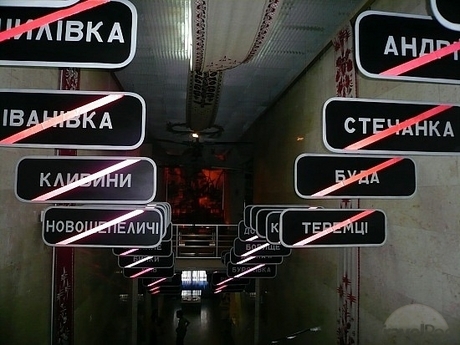National Chernobyl Museum
This museum is a mixture of artistic representations of the disaster, artefacts from the site itself and model reconstructions commemorating the heroics of the first rescue workers, many of whom died fighting the fire. Dozens of signs hanging from the ceiling makes a haunting memorial to the evacuated towns still too dangerous to live in.
The Ukrainian National Chernobyl Museum is a museum dedicated to the Chernobyl disaster. The museum is located in the city of Kiev, Ukraine. It houses an extensive collection of scale models, visual media, memorabilia, artifacts, and other representational items designed to educate the public about many aspects of the Chernobyl disaster. Several exhibits depict the technical progression of the accident, and there are also many areas dedicated to the loss of life and cultural ramifications of the disaster. Due to the nature of the subject material, the museum provides a very visually engaging experience.
A display of road signs for various settlements near Chernobyl. Abandoned areas inside the zone of alienation are struck out with a pink slash.Guided tours in English may be available, and the main parts of some exhibits have already been translated. Recorded audio is available in English and other languages. The museum has received funding from the Japanese government.
The Nuclear accident at the Chornobyl Nuclear Power Plant entered the history of the humankind as the most severe radioecological disaster of the XX century. The after-effects of it have no analogy and differ from another natural or manmade catastrophes. These are still the issues of contemporaneity and, unfortunately, of the generation to come. The National museum “Chornobyl” conveys the history of those tragic-events since the 26th of April, 1992.
The mission of the museum is to help the mankind understand the scope of the disaster through the destinies of thousands of those people who witnessed the accident, participated in the mitigation and suffered from the disaster. The aim is to make people realize the necessary of reconciliation between man, science and technology that endanger the existence of the human civilization and Earth, to conceive the lessons of the tragedy in all the spheres of life, lest the world forget the lessons of Chornobyl. The museum is warning for the new millennia generations.
Many visitors to Ukraine will be fascinated to discover more about the famous nuclear disaster that occurred in 1986 just 100km away from Kiev. The Chernobyl Museum is a natural place to start. Although there is limited information in English, hundreds of photos chronicling the explosion and the aftermath tell a lot of the story, without the need for words. Meanwhile, exhibits of the extensive protective clothing required for fighting the fire, as well as animals mutated by subsequent radiation poisoning, reinforce the horror. A number of artistic tributes to the victims are particularly evocative too.
The National “Chernobyl” Museum was opened on April 26, 1992, on the fifth anniversary of the accident at the Chernobyl station. Exposition was collected slowly, because there were almost no information, and all the data on the causes and consequences of the accident were strictly confidential. Many materials were published at the museum for the first time – documents, maps, and photos labelled «Confidential».
Museum «Chernobyl» exhibition tells about one of the biggest disasters in human history – the accident at the fourth power generating unit of Chernobyl nuclear power station, which occurred in April 1986. The museum contains more than 7000 exhibits – documents, photographs, items of ethnic culture, personal belongings of participants of elimination of the accident consequences.
Above the entrance to the museum there is written phrase «Est dolendi modus, non est timendi» (There is a limit of sadness, but there is no limit for worries). Then there is the bar with flashing lights, opening the entrance to the symbolic Chernobyl road. This is a staircase that leads to the main museum hall; along the road there are signs with the names of 76 towns and villages of Ukraine from the resettlement zone, razed to the ground with radiation.
After the Chernobyl road the first exhibition hall starts; the floor in it is made as a slab of biological defence of the main reactor hall. There is an iconostasis in the centre of the room stands; the museum staff brought the parts of it from a Voskresensky church in the Zone of Alienation. The boat is swinging under the iconostasis; it is a symbol of Noah’s ark and inside the boat there are children’s toys left by visitors of the museum. On the ceiling of the room there is a symbolic map of the world with flashing red lights of power stations on all continents.
The museum has the unique videos of the disaster and its consequences, the model of the power unit of Chernobyl nuclear power plant, a diorama called «Chernobyl nuclear power plant before, during and after the accident», showing the explosion, the destruction of the nuclear power plant after it, and the construction of the sarcophagus over the exploded block.
The museum exhibition halls show the heroic and selfless work of people who participated in the work of elimination of accident consequences. In 1998 in the museum a memory e-book of participants who eliminated the accident was set up; it contains more than 5 thousand names of liquidators.
Since its inception, the “Chernobyl” museum was attended by representatives of more than 80 countries of the world. Among them were the Presidents of Ukraine and other countries, the UN mission headed by Secretary -General Kofi Annan, President of the OSCE Adrian Severin and others.




